unemployment, a shortage of housing, and the need to diversify the
petroleum-based economy.
Geography Algeria
Location:
Northern Africa, bordering the Mediterranean Sea, between Morocco
and Tunisia
Geographic coordinates:
28 00 N, 3 00 E
Map references:
Africa
Area:
total: 2,381,740 sq km
water: 0 sq km
land: 2,381,740 sq km
Area - comparative:
slightly less than 3.5 times the size of Texas
Land boundaries:
total: 6,343 km
border countries: Libya 982 km, Mali 1,376 km, Mauritania 463 km,
Morocco 1,559 km, Niger 956 km, Tunisia 965 km, Western Sahara 42 km
Coastline:
998 km
Maritime claims:
exclusive fishing zone: 32–52 NM
territorial sea: 12 NM
Climate:
arid to semiarid; mild, wet winters with hot, dry summers along
coast; drier with cold winters and hot summers on high plateau;
sirocco is a hot, dust/sand-laden wind especially common in summer
Terrain:
mostly high plateau and desert; some mountains; narrow,
discontinuous coastal plain
Elevation extremes:
lowest point: Chott Melrhir −40 m
highest point: Tahat 3,003 m
Natural resources:
petroleum, natural gas, iron ore, phosphates, uranium, lead, zinc
Land use: arable land: 3.21% permanent crops: 0.21% other: 96.58% (1998 est.)
Irrigated land:
5,600 sq km (1998 est.)
Natural hazards:
mountainous areas subject to severe earthquakes; mudslides and
floods in rainy season
Environment - current issues:
soil erosion from overgrazing and other poor farming practices;
desertification; dumping of raw sewage, petroleum refining wastes,
and other industrial effluents is leading to the pollution of rivers
and coastal waters; Mediterranean Sea, in particular, becoming
polluted from oil wastes, soil erosion, and fertilizer runoff;
inadequate supplies of potable water
Environment - international agreements:
party to: Biodiversity, Climate Change, Desertification, Endangered
Species, Environmental Modification, Hazardous Wastes, Law of the
Sea, Ozone Layer Protection, Ship Pollution, Wetlands
signed, but not ratified: Nuclear Test Ban
Geography - note:
second-largest country in Africa (after Sudan)
People Algeria
Population:
32,818,500 (July 2003 est.)
Age structure:
0–14 years: 32.8% (male 5,485,197; female 5,285,434)
15–64 years: 63% (male 10,460,475; female 10,224,389)
65 years and over: 4.2% (male 624,839; female 738,166) (2003 est.)
Median age:
total: 22.5 years
male: 22.3 years
female: 22.6 years (2002)
Population growth rate:
1.65% (2003 est.)
Birth rate:
21.94 births/1,000 population (2003 est.)
Death rate:
5.09 deaths/1,000 population (2003 est.)
Net migration rate:
−0.4 migrant(s)/1,000 population (2003 est.)
Sex ratio:
at birth: 1.04 male(s)/female
under 15 years: 1.04 male(s)/female
15–64 years: 1.02 male(s)/female
65 years and over: 0.85 male(s)/female
total population: 1.02 male(s)/female (2003 est.)
Infant mortality rate:
total: 37.74 deaths/1,000 live births
female: 35.02 deaths/1,000 live births (2003 est.)
male: 40.34 deaths/1,000 live births
Life expectancy at birth:
total population: 70.54 years
male: 69.14 years
female: 72.01 years (2003 est.)
Total fertility rate:
2.55 children born/woman (2003 est.)
HIV/AIDS - adult prevalence rate:
0.1% - note: no country specific models provided (2001 est.)
HIV/AIDS - people living with HIV/AIDS:
NA
HIV/AIDS - deaths:
NA
Nationality:
noun: Algerian(s)
adjective: Algerian
Ethnic groups:
Arab-Berber 99%, European less than 1%
Religions:
Sunni Muslim (state religion) 99%, Christian and Jewish 1%
Languages:
Arabic (official), French, Berber dialects
Literacy:
definition: age 15 and over can read and write
total population: 70%
male: 78.8%
female: 61% (2003 est.)
Government Algeria
Country name:
conventional long form: People's Democratic Republic of Algeria
conventional short form: Algeria
local short form: Al Jaza'ir
local long form: Al Jumhuriyah al Jaza'iriyah ad Dimuqratiyah ash
Sha'biyah
Government type:
republic
Capital:
Algiers
Administrative divisions:
48 provinces (wilayas, singular - wilaya); Adrar, Ain Defla, Ain
Temouchent, Alger, Annaba, Batna, Bechar, Bejaia, Biskra, Blida,
Bordj Bou Arreridj, Bouira, Boumerdes, Chlef, Constantine, Djelfa,
El Bayadh, El Oued, El Tarf, Ghardaia, Guelma, Illizi, Jijel,
